
Storing Baby Formula in Mylar Bags
As a prepper, you understand the importance of being prepared for any situation. When it comes to ensuring that your baby’s nutritional needs are met

In the realm of prepping, where self-sufficiency is paramount, the humble seed emerges as a silent hero. As the key to sustained food production and self-reliance, proper storage of seeds becomes a crucial aspect of any prepper’s strategy. In this guide, we delve into the art and science of seed storage, exploring methods to ensure the longevity and viability of your seed bank.
Seeds represent the potential for future harvests, making them a cornerstone in prepping efforts. Whether you’re preparing for a temporary disruption or a long-term survival scenario, having a well-preserved seed bank is like holding the keys to your food security. Proper seed storage not only extends the shelf life of seeds but also maintains their germination rates, ensuring a renewable source of sustenance.
Before delving into the intricacies of seed storage, it’s essential to choose the right seeds for your prepping needs. Opt for heirloom or open-pollinated seeds, as these varieties allow you to save and replant seeds from each harvest. Unlike hybrid seeds, which do not reliably produce the same traits in subsequent generations, heirloom seeds maintain their genetic integrity, providing a sustainable source of seeds for years to come.
Preserving seed viability hinges on creating optimal storage conditions. Seeds are sensitive to moisture, temperature, and light, so it’s crucial to store them in a cool, dark, and dry environment. Consider using airtight containers to protect seeds from moisture and pests. Vacuum-sealed bags or glass jars with desiccant packets can be effective tools in maintaining the right moisture levels.
The choice of containers plays a vital role in successful seed storage. While glass jars and mylar bags are popular choices, it’s essential to ensure they are airtight and provide protection against external elements. Consider adding a few silica gel packets to absorb any residual moisture, further safeguarding your seeds against degradation.
To maintain a dynamic and reliable seed bank, rotation is key. Seeds have a finite lifespan, and regular rotation ensures that you’re always working with fresh and viable seeds. Properly labeling your containers with the seed variety and date of storage helps you keep track of the age of your seeds, allowing for systematic rotation and usage.
For preppers anticipating extended periods of self-sufficiency, exploring long-term storage techniques becomes imperative. Seed vaults, which mimic the conditions of natural seed dormancy, can be utilized for extended storage. These vaults often involve freezing seeds in a controlled environment, preserving their viability for decades.
In addition to physical seed storage, investing in knowledge and skills related to seed saving and propagation is equally crucial. Understanding the lifecycle of plants, proper harvesting techniques, and seed-saving practices empowers preppers to not only store seeds but also renew their seed bank through sustainable practices.
In conclusion, seed storage for prepping is not merely about stashing away packets in a dark corner. It’s a meticulous process that involves careful selection, proper storage conditions, and continuous learning. By embracing these practices, preppers can ensure that their seed bank becomes a renewable source of life-sustaining nutrition, making seeds the silent saviors in times of need.

As a prepper, you understand the importance of being prepared for any situation. When it comes to ensuring that your baby’s nutritional needs are met

If you’re a fan of probiotic-rich foods, you’ve probably heard of kefir. This tangy, fermented drink is packed with beneficial bacteria and yeast, making it

Making your own butter at home is a rewarding and surprisingly simple process. With just a few basic ingredients and tools, you can create rich,